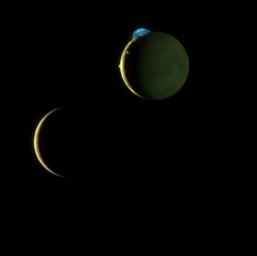This beautiful image of the crescents of volcanic Io and more sedate Europa is a combination of two New Horizons images taken March 2, 2007, about two days after New Horizons made its closest approach to Jupiter. A lower-resolution color image snapped by the Multispectral Visual Imaging Camera (MVIC) at 10:34 universal time (UT) has been merged with a higher-resolution black-and-white image taken by the Long Range Reconnaissance Imager (LORRI) at 10:23 UT. The composite image shows the relative positions of Io and Europa, which were moving past each other during the image sequence, as they were at the time the LORRI image was taken.
This image was taken from a range of 4.6 million kilometers (2.8 million miles) from Io and 3.8 million kilometers (2.4 million miles) from Europa. Although the moons appear close together in this view, a gulf of 790,000 kilometers (490,000 miles) separates them. Io's night side is lit up by light reflected from Jupiter, which is off the frame to the right. Europa's night side is dark, in contrast to Io, because this side of Europa faces away from Jupiter.
Here Io steals the show with its beautiful display of volcanic activity. Three volcanic plumes are visible. Most conspicuous is the enormous 300-kilometer (190-mile) high plume from the Tvashtar volcano at the 11 o'clock position on Io's disk. Two much smaller plumes are also visible: that from the volcano Prometheus, at the 9 o'clock position on the edge of Io's disk, and from the volcano Amirani, seen between Prometheus and Tvashtar along Io's terminator (the line dividing day and night). The Tvashtar plume appears blue because of the scattering of light by tiny dust particles ejected by the volcanoes, similar to the blue appearance of smoke. In addition, the contrasting red glow of hot lava can be seen at the source of the Tvashtar plume.
The images are centered at 1 degree North, 60 degrees West on Io, and 0 degrees North, 149 degrees West on Europa. The color in this image was generated using individual MVIC images at wavelengths of 480, 620 and 850 nanometers. The human eye is sensitive to slightly shorter wavelengths, from 400 to 700 nanometers, and thus would see the scene slightly differently. For instance, while the eye would notice the difference between the yellow and reddish brown colors of Io's surface and the paler color of Europa, the two worlds appear very similar in color to MVIC's longer-wavelength vision. The night side of Io appears greenish compared to the day side, because methane in Jupiter's atmosphere absorbs 850 nanometer light and makes Jupiter-light green to MVIC's eyes.

 Planetary Data System
Planetary Data System












